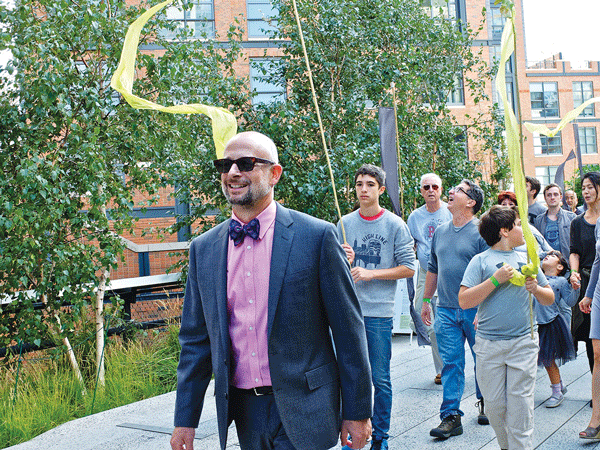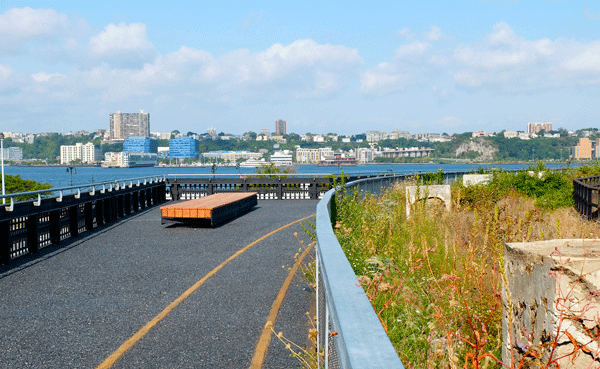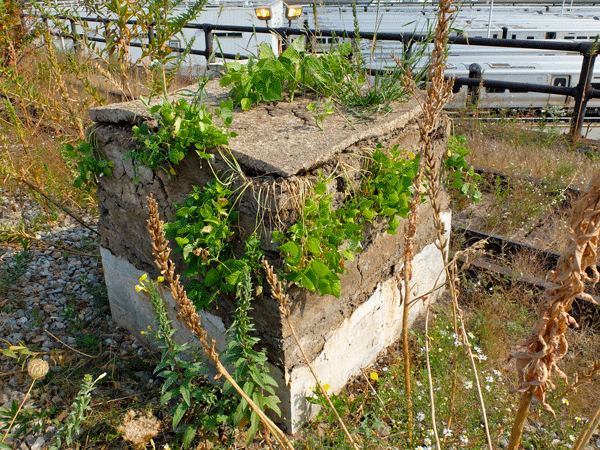
BY DUSICA SUE MALESEVIC | The High Line’s third and final section officially opened last Sunday. The new segment is: A. exactly like the other two, B. nothing like the other two, or C. a distinct part that fits with the whole. If you chose C, you’ve won free admission to the park!
O.K., the park is always free — but the new half-mile-long section, located between W. 30th and 34th Sts., dubbed the “High Line at the Rail Yards,” offers singular panoramas and features.
For the first time, the High Line will have a feature specifically designed for children, namely, the Pershing Square Beams. To create this play area, the cement decking that previously held up the track ballast was removed. This revealed the steel girders that make up the park’s structural form, and a walkway was then ramped down that allows children to enter the gird work.
All of these beams have been covered with a rubberized playground material for safety, and there are a number of interactive features: speaking tubes, periscopes and something dubbed the “gopher hole,” where children can go into the hole and then stick their head up in the planting beds.

Another important distinction of the third section is the way the Friends of the High Line has treated it: as a found object.
The “Interim Walkway” that blooms with wild plants on one side of this section preserves how the park looked in the years following its use as an active freight-rail viaduct. The “Interim Walkway” comprises about half of the new section and will offer the general public its first opportunity to see that original landscape.
In an interview, Joshua David, co-founder of Friends of the High Line, explained that, after the trains stopped running, seeds drifted or were dropped by birds there, taking root in the High Line’s gravel ballast. Although it was an inhospitable landscape, those seeds grew into a lush natural wilderness of grasses, small shrubs and meadow flowers.
“The Interim Walkway is a part of the High Line that we basically left in its natural condition, the way that we found it,” David said. “That’s what Robert Hammond [the Friends of the High Line’s other co-founder] and I first discovered some 15 years ago when we started this project, and it was the landscape that really inspired us to make a park on the High Line.”
Another special aspect of this new section is its openness. While the park’s other two sections are hemmed in by buildings on either side for much of their length, that’s not the case here.
The Interim Walkway follows the original train tracks along a curve that allows one to feel the nearness of the Hudson River and forget for a moment the surrounding city — until, of course, the dissonance of hammers pounding and the “zzz” of a construction saw at nearby construction sites, and car horns blaring, make parkgoers realize they’re not on a pier at a beach.
“It’s definitely a lot more open,” said James Petty, 31, a Hell’s Kitchen resident in the park last weekend. He and another Hell’s Kitchen resident, Michael McGrattan, 30, faced out toward the rail yards — the many trains looking like the arms of an ancient god reaching out while cranes near buildings stretched for sky — and contemplated the Hudson Yards construction.
“It’s very exciting to see the whole thing finally done,” said Brandon Warshofsky, 24. He and Esther Ryang, 23, both of Newark, N.J., were late for the People’s Climate March and decided to venture for pickles and the High Line instead. They also enjoyed the High Line’s latest artwork.
An installation by Adrian Villar Rojas titled “The Evolution of God” graces the new section. Twelve cubes were spaced out perpendicularly to the Interim Walkway on the side lush with vegetation, and employed random materials — socks, clothes, ropes and shells — to create layers within the blocks. Some of these already had foliage growing out of them.
Rojas’s installation will remain for the year. During that time, it will have vegetation growing on it and from it, but will also in some places decay or change form.
The bees could not stay away from the new, flower-filled park last Sunday, and neither could the people. Members of Friends of the High Line were keeping count at half-hour intervals and by 5 p.m. 9,300 people had already visited.

Fanfare, fun and frivolity marked the ribbon-cutting ceremonies on a balmy Saturday before the opening. A procession included several community members and groups, as well as the resplendent Lesbian & Gay Big Apple Corps Marching Band, whose dancers shook and shimmied while the band laid down the beat. Each group had its own color and flags and carried a huge rail-yard signal that highlighted a different aspect of the neighborhoods — present and historic — that the park passes through: a cow with its parts delineated for the Meatpacking District, as well as multicolored lips, drag queens, clothes and ships were featured.
As politicians and David, of the Friends, spoke in the elevated park’s new section, the wind joined in the celebration. It caressed the foliage, which swayed in the gentle gusts, as the community’s medieval-like flags waved.
For the Friends of the Highline, the third section’s opening is the fulfillment of a key part of the group’s original vision.
“To us, that’s an incredible moment to arrive at,” David told The Villager. “It’s taken us 15 years, which can seem like a long time, but it’s actually a fairly short time for a project of this scope, which faced such tremendous challenges at the very beginning.”
The final segment’s opening also means that there is 50 percent more park for the organization to maintain and operate.
“The Friends of the High Line provides almost all the operation funding for the park, so it does pose a new challenge for us,” David said.
There will be more staff hours to fund and manage to ensure that the High Line continues to be impeccably maintained, he said.
“We’re very optimistic that we will keep it as beautifully as we have done in the first two sections,” David said. “I’m confident that we’ll determine a path that makes the High Line a strong and sustainable organization for the long haul.”

















